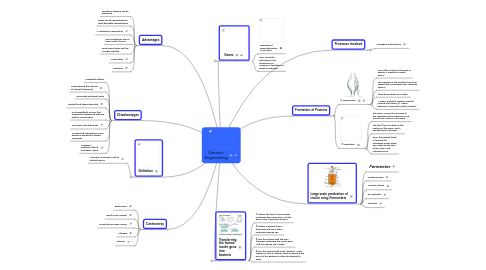Genetic Engineering
by Alexa Lee


1. Genes
1.1. Segments of Deoxyribonucleic Acids (DNA)
1.2. DNA stores the information that determines an organism's hereditary or genetic properties.
2. Definition
2.1. Alteration of genetic code by artificial means
3. Advantages
3.1. Hereditary diseases can be prevented
3.2. Genes can be manipulated to show desirable characteristics
3.3. A revolution in agriculture
3.4. More productive due to larger yield of crops
3.5. Food ripens faster and has a longer shelf-life
3.6. Aquaculture
3.7. Evolution
4. Disadvantages
4.1. Irreversible effects
4.2. Compromised the richness of natural biodiversity
4.3. Decreased nutritional value
4.4. Natural food chains disrupted
4.5. Not scientifically proven that Genetically Engineered food are safe for consumption
4.6. Decrease in food diversity
4.7. Unexpected characteristics may appear in genetically altered organisms
4.8. Increased pollution of food and water supply
5. Controversy
5.1. Emphysema
5.2. Death Case (Human)
5.3. Animal Testing Gone Wrong
5.4. Allergies
5.5. Cloning
6. Transferring the human insulin gene into bacteria
6.1. 1) Obtain the human chromosome containing the insulin gene. Cut the gene using a restriction enzyme.
6.2. 2) Obtain a plasmid from a bacterium and cut it with a restriction enzyme too.
6.3. 3) Mix the plasmid with the DNa fragment containing the insulin gene. Add the enzyme DNA ligase.
6.4. 4) Mix the plasmid with E.coli. bacteria. Apply temporary heat or electric shock to open up the pores of the bacteria to allow the plasmid to enter
7. Processes Involved
7.1. Transgenic Manipulation
8. Formation of Proteins
8.1. 1) Transcription
8.1.1. One of the strands in the gene is used as a template to make mRNA.
8.1.2. The message in the template has to be copied into a messenger RNA molecule (mRNA).
8.1.3. Three bases make up a codon.
8.1.4. A mRNA molecule contains Uracil(U) instead of Thymine (T). Hence, adenine(A) pairs with uracil(U) instead.
8.2. 2) Translation
8.2.1. The mRNA carries the message to the cytoplasm where ribosomes and transfer RNA (tRNA) are present.
8.2.2. The first 2 tRNAs attach to the codons on the mRNA and a peptide bond is formed.
8.2.3. Once the peptide bond is formed, the ribosomes moves along one codon to the right of the mRNA and releases tRNAs.
